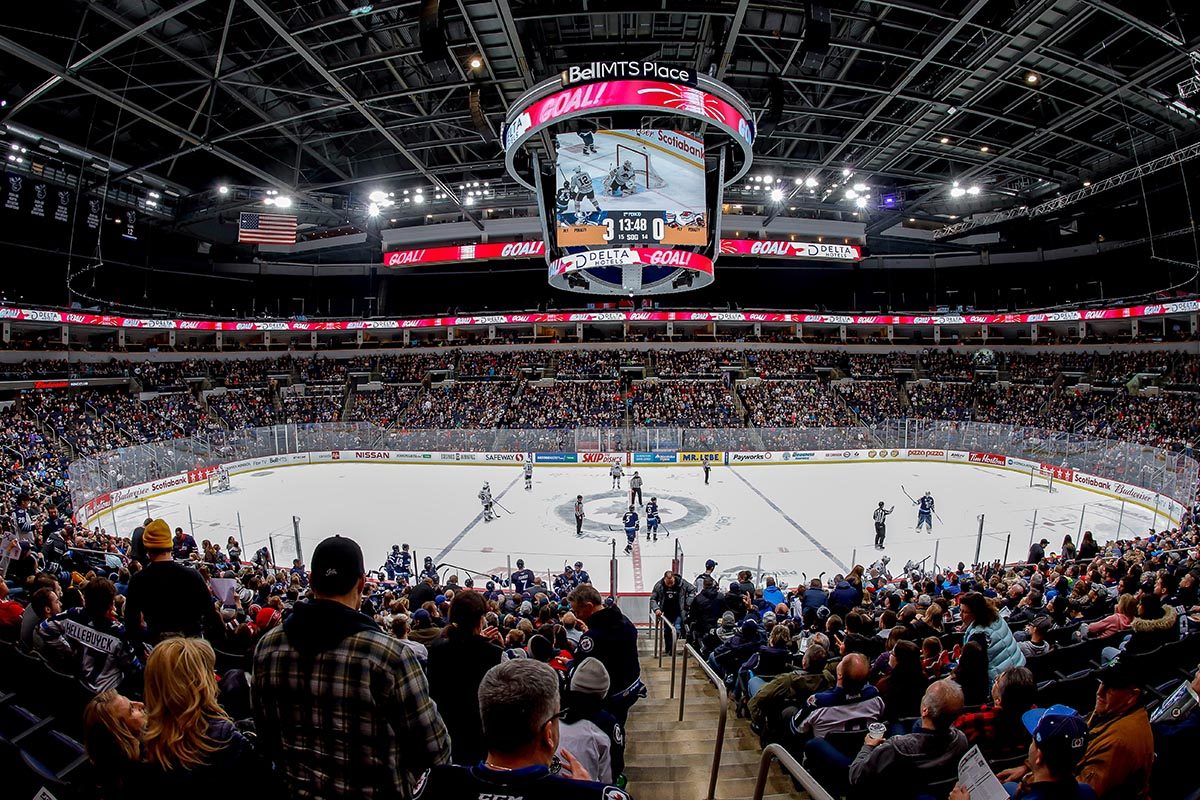by Jennifer Redenbach | AHL On The Beat
Most NHL clubs are miles away from their AHL affiliate. When a player is called up to the bigs, it may take hours, or even a day of travel to get the player to where he needs to go. In the case of the Winnipeg Jets and their AHL affiliate the Manitoba Moose, however, they are separated by no more than a hallway.
Both the Jets and the Moose call Bell MTS Place home. The clubs also train and out of Bell MTS Iceplex. With the clubs operating out of the same building, it holds a bonus of convenience when a player is called up because of both proximity and team structure.
“When you switch teams, you don’t have to uproot your life as much, you can just go to the other side of the building,” said Jets defenseman Tucker Poolman, who suited up for the Moose from 2017-19. “It works great because the systems are the same with both teams and the coaches are on the same page. It pertains both to the language they use and the different terms they use. That was really nice for a player because it’s more seamless.”
The first adjustment a player makes when joining a new team is becoming accustomed to new surroundings. When a player is called up to the Winnipeg Jets, the player is already familiar with the building and well acquainted with the people they need to depend on in their daily activities.
“I’ve really gotten to understand how important it is to feel comfortable in the environment that you are playing in to be able to succeed,” said Moose defenseman Nelson Nogier. “By having both teams under the same roof it really sets you up to be able to do that.”

The learning experiences a player gains during a recall can not only aid their development on the ice but off the ice as well. Poolman notes that when he was recalled in his early years, one of the key components of the NHL game he assimilated into his daily regimen was what he saw behind the scenes.
“You can watch and see how guys go about their daily routine and how they get ready for a game,” said Poolman. “How they deal with a back-to-back or on an off day how they take care of their bodies and what they do on the ice so you can learn a lot that way too in how to take of yourself.”
Being prepared for a call up goes beyond the moment a player walks down the tunnel and onto the sheet. Everything ranging from a player’s health, workouts, practices and daily activities can influence a player’s stature to play at the next level and as Nogier expressed they have an excellent support system to lean on.
“We are so lucky to have such a tremendous staff around us. They prepare us in every possible way to help us succeed when we’re ready to make that jump,” said Nogier.
Nogier was selected by the Jets in the fourth round of the 2014 NHL Entry Draft. The Saskatoon, Sask., product has appeared in 11 games for Winnipeg throughout his NHL career and played a total 191 games in the AHL while racking up 29 points (three goals, 26 assists). With his experience playing for both clubs, the defenseman serves as a role model for the younger players striving to develop.
“I take pride in being a leader around the room,” Nogier said. “Just to be able to lead by example and make sure that those young guys do all the details right. Because those are the type of things that allowed me to make the most of the opportunities that have been presented to me. I want the best for my teammates, and I want the young guys to make the most of their opportunities as well.”
Many of the veteran players have experienced the process of being called up to the NHL and are familiar with the adjustments to joining a new team. With this, the mentorship they can provide for developing prospects is invaluable.
Take Moose forward Logan Shaw. The Glace Bay, N.S., native has been a force for Manitoba. Shaw paced the Moose with 27 goals in 63 games during the 2018-19 campaign and ranked second on the team with 46 points. He has spent significant time with both clubs this season, appearing in 16 games with the Moose and 25 games with the Jets.

As a veteran player, Shaw can relate to how a strong support system and positive mentorship can impact a player’s development.
“It’s one of the hardest things to do. Confidence is one of the biggest things that can make or break a player,” Shaw explained. “When I was first getting called up, I had guys who would help me out, and it’s the same type of thing. They are a bit older but they had experience in both leagues. I think for myself it’s a good aspect to have to be able to help those guys out.”
Once a player is able to shake off the nerves that comes with making the jump to the show and find their confidence in what got them there, Shaw explains how if a player can embrace their time with the big club and fine tune their craft by exposure, that is when a player can truly bloom.
“You see what you need to work on, the size, the speed or the little details. You may not be there yet, but I think being up and down you realize what you need to do to stay there,” Shaw said.
With the goal in mind being to develop prospects, a major objective for Manitoba is to implement the Winnipeg Jets systems into the Moose style of play. Jansen Harkins is a recent example as to how this can pay off in a player’s transition to the NHL. Harkins spent two full seasons developing with the Moose before earning his shot with the Jets. The forward began the 2019-20 campaign with Manitoba where he posted 31 points (seven goals, 24 assists) in 30 games. He was recalled by Winnipeg on Dec. 18 and made his NHL debut on Dec. 21 against the Minnesota Wild, going on to post two assists in 11 NHL games.
During a pre-game interview on Dec. 23, Jets head coach Paul Maurice told reporters he credits Harkins’ smooth transition to the NHL to his time with the Moose.
“He knows the system,” said Maurice. “He knows what he’s supposed to do, so he’s not coming to the bench wondering was I in the right spot. Pascal Vincent and his staff, they know where they are supposed to be. He went out there and wasn’t spending a lot time trying to process the game and went as fast as he could, and he did a good job.”
The benefits of having an NHL team in the same city as it’s AHL affiliate does not only pertain to the players. It also provides a special experience for those watching on from the stands.
“I think for the fans too, it’s exciting,” Winnipeg Jets defensemen Josh Morrissey said in a recent interview. “You can watch a player play for the Moose and develop right in front of your eyes and then be on the same ice surface the next weekend or years later for the Jets.”
Morrissey alluded to one of the many reasons that Winnipeg holds hockey so close to its heart – not many fan bases can invest in a player’s career as a young prospect and watch them grow into to an NHL competitor.
With the convenience of the location, the coaching staff on the same page, and a support system instilled in the organization, the players are set up for success. All that’s left to do is to make the jump. Luckily, they don’t have to go any further than the end of the hallway to get there.






































